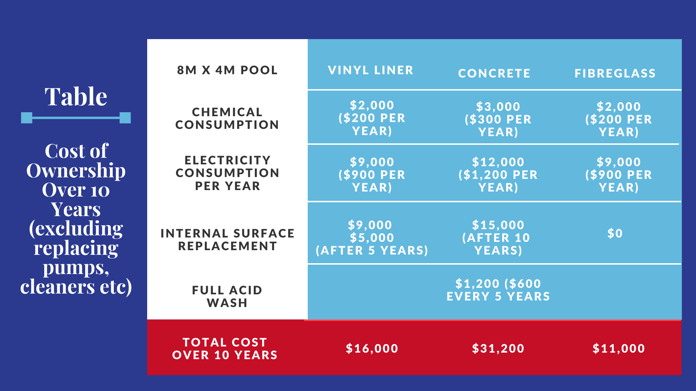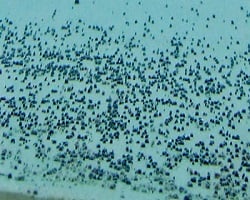Concrete Pools v Fibreglass Pools - Which Is Cheaper To Maintain?
Concrete and fibreglass swimming pools have clear differences in the ongoing cost to maintain and it's thousands of your hard earned after tax dollars. Just because one is cheaper than the other doesn't mean it is a better swimming pool for you. What is most important is choosing a pool that is the best fit for your family and annual maintenance budget and knowing the costs before you buy your pool.
Like any big cost purchase, make sure you consider the total cost over 10 years, not just the initial upfront cost. Swimming pools are like cars. They generally look the same however the annual running costs vary hugely between models and brands.
The common costs associated with all pool types are;
- chemicals to sanitise the water
- electricity to run the pump, chlorinator and filter to maintain water quality and sanitisation
- the amount of time you spend, or pay someone, to keep the pool well maintained, clean and ready for use.
- electricity to run water features, heat pumps and automatic cleaners
- maintaining the internal surface of the pool
The table below compares concrete, vinyl liner and fibreglass pool shell annual maintenance costs. Assuming an 8m x 4m pool that is regularly maintained, a concrete pool will typically use more chemicals and require more time to keep the water safe for friends and family and to prevent black spot algae than fibreglass pool shells and vinyl liner pools. Why?

Chemical Usage and Algae Prevention
Concrete is naturally high in pH so you’ll regularly use more acid keeping the pH levels of your water in the right range. High pH reduces chlorine effectiveness. Chlorine helps to keep algae under control so you’ll use a higher volume of chlorine to maintain safe sanitation levels and prevent an algae bloom.
In terms of the dreaded Black Spot algae, the internal surface of a concrete pool is porous with tiny holes that are ideal for microscopic algae and bacteria to grow in. With vigilant water chemistry management and frequent brooming down of the walls and floors, algae spores can be kept at bay. Black Spot algae is more commonly associated with concrete pools and once present, is difficult and expensive to remove. If the algae gets in behind the plaster surface, the pool may need to be resurfaced to completely remove the algae.
frequent brooming down of the walls and floors, algae spores can be kept at bay. Black Spot algae is more commonly associated with concrete pools and once present, is difficult and expensive to remove. If the algae gets in behind the plaster surface, the pool may need to be resurfaced to completely remove the algae.
The gel coat internal surface of a fibreglass pool shell is non-porous and inert so there is no impact on pH levels. If your pool has a gel coat mixed with an anti-microbial, 99% of a pools bacteria will be killed in conjunction with normal filtration. A fibreglass swimming pool shell needs less chemicals to maintain water sanitation. Algae still occurs in fibreglass pools if not properly maintained, however a single dose of algaecide usually solves the problem.
The advantage of a concrete pool is the ability to build really deep pools. While the average depth of a well made fibreglass 8m pool is 1.90m (or 1.70m if the pool is cheaply made), concrete is 2m+. The deeper the pool, the more water that must be cycled through the filter daily which requires more chemicals and a larger capacity pump which will use more electricity annually. Naturally, the deeper a swimming pool, the more water it will hold. If you are heating your pool, the greater the volume of water, the higher the heating costs.
Wall and Surface Cleaning
Concrete pools need frequent brushing down of the walls for the prevention of black spot algae and maintenance of the plaster surface. A good quality robot pool cleaner ($2,000) will help reduce the time you are on a broom. Make sure the robot is designed to scrub concrete pool walls when checking the different robots out there. Fibreglass still needs to be broomed down if you don't have a suction or robot cleaner, however less frequently. If your fibreglass pool has structural reinforcing ledges (often marketed as "safety ledges" for kids), you will need to frequently manually broom these ledges down and the walls above them. Suction and robot cleaners can't clean these structural ledges which collect a lot of dirt, which is why they are often called "dirt collecting ledges" by pool owners (fortunately our pools are completely flat and pool cleaner friendly). If you are going to hire a pool service business to clean your pool for you, allow for between $80 and $150 per visit.
Resurfacing
The plaster surface of a concrete pool is slowly eaten away and needs to be resurfaced every 10 to 15 years. If the pH levels are not well maintained, it will be closer to 8 to 10 years. Aside from the cost to remove the plaster surface and plastering on a new surface, the pool has to be completely drained. Once refilled, balancing 40,000 litre of water needs a hefty amount of chemicals.
Over time, micro thin layers of calcium and other minerals coat the inside of concrete pools which leads to a dull appearance. An acid wash is usually required every 5 to 7 years to bring back a brighter, newer look (like cut and polishing dull paint on a car). The downside is the diluted muriatic acid removes a thin layer of plaster each time and should only be done by a professional (this is not a watch Youtube and DIY gig to save money thing!). Don’t schedule an acid wash during water restrictions as the entire pool has to be drained and refilled and another hefty dose of chemicals is needed to be bought and applied. Replacing the surface of your concrete pool every 10-15 years, for most owners, is a choice between the pool and an overseas holiday with the kids. With fibreglass, you can send the neighbours a postcard from Fiji.
Replacing your vinyl pool liner every 5-8 years is costly which offsets some of the savings when first buying the pool. The vinyl breaks down from the pool chemicals and the sun. Usually a few leaks or a tear in the liner is the warning sign to replace the liner.
If a quality, 100% pure Australian made marine grade gel coat is used, fibreglass pools rarely need to be resurfaced before 20 years and often it is longer (if properly maintained). If the thickness of the gel coat layer is reduced or the gel coat is diluted by a manufacturer trying to save money, resurfacing a fibreglass pool will most likely be needed sooner. A quality gel coat finish will also be fade and UV resistant, which keeps the surface looking bright without needing acid washes or resurfacing.
Heating
If you need a heating pump or gas heater to warm your water to swimming temperature, be prepared for a decent increase in your power or gas bill. The colder the water and the deeper the pool, the higher the electricity or gas use. Of the three, fibreglass pools are warmer and cheaper to keep heated to your ideal temperature, closely followed by vinyl liner pools, with concrete the most expensive. Concrete pools tend to be colder than other types of pools (think how cool concrete floors feel to the touch).
Key Takeaway– With a pool, it is vitally important to work out what the overall cost of your pool will be over 10, 15 and 20 years as the difference will be thousands rather than hundreds of dollars. The lifetime financial cost of a concrete pool or a vinyl liner pool is higher than the initial cost to install the pool. The lifetime cost in your time (or paying for someone else’s time) is highest for a concrete pool and lowest for a fibreglass pool.
Related Blogs
There’s nothing like stepping into your DIY plunge pool after a long day. You installed it, you love it, and it’s your little slice of paradise. Just like your lawn, your pool isn’t set and forget -....
You're envisioning the perfect backyard—relaxing by a pool that suits your style, your budget, and your maintenance limits. But with so many choices, where do you even begin? Do you go with the....
Ever thought about installing your own fibreglass pool? You’re not alone—it’s exciting, but maybe a little nerve-wracking too, right? The good news is, with the right plan and a bit of elbow grease,....
About The Author
My wife and I grew up playing in swimming pools. Our daughters learnt to swim in our backyard fibreglass swimming pool. There is nothing quite like hearing kids splashing about and giggling. As pools do, our pool became a social magnet for friends, family and neighbours which we loved. Helping customers to have their own pool and saving customers thousands on their pool and equipment is the best job in the world.





